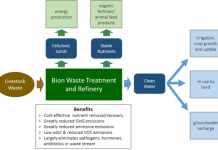There has been a lot written lately about how to turn climate change into an investment opportunity, including on this site. Not all of it is, however, especially useful or relevant. In the worst cases, commentators have ascribed the ‘climate change investment opportunity’ label to just about any industry out there, indiscriminate of whether or not there really is a strong and direct connection. If you are seriously interested in playing the climate story, you should stay focused on near and medium term opportunities with real and tangible links to what is currently going on with the climate file. In plain English, this means that if you invest your money in a boat maker tomorrow because you expect sea levels to rise at some point in the future, you may not be putting your money to its best possible use. Regulation: Where Real Climate Opportunities Lay The most immediate investment opportunities related to climate change are connected to regulatory developments such as the EU Emissions Trading Scheme (ETS), the Regional Greenhouse Gas Initiative (RGGI) and California’s AB 32 (PDF document). These regulatory initiatives all have the same intent: to cap emissions of greenhouse gases (GHG) across a range of industrial sectors. As such, they will create demand for certain technologies and solutions for which there would otherwise be no market. We have discussed opportunities linked to carbon finance on several occasions in the past. Today, I want to speak about another area that is sure to get a boost for climate change legislation: end-of-pipe technologies to control emissions of GHG. There are 2 main approaches to end-of-pipe GHG control: (1) carbon capture and storage (CCS) and (2) technologies seeking to transform the CO2 contained in flue gas into an innocuous – or even useful – commodity. The former has been in the news a lot over the past few months but the latter has pretty much fallen below the radar, mostly because these technologies are only just emerging and investing in them at this stage can be considered speculative. This is what I want to discuss today, and will leave CCS for another post. Managing GHG Emissions: No Need to Re-invent the Wheel Most of our readers will no doubt be familiar with just how prevalent coal is in power generation today, and how this role is not forecasted to diminish over the next 2 decades (see also Tom’s excellent article on investing in peak coal published a few days ago). Coal is the ‘dirtiest’ of fossil fuels and burning it to make electricity is often blamed for contributing significantly to global GHG emissions. A number of companies are now working to find ways to make coal ‘cleaner’ by removing carbon dioxide from flue gas and transforming it into something either neutral or useful, rather than burying underground as is the case with CCS. Such solutions can be applied to any industrial process that entails a pipe spewing out GHG, but the most immediate opportunities are definitely related to coal-based power generation. The primary appeal of end-of-pipe solutions is that they don’t entail ‘re-inventing the wheel’, meaning that they can be appended to existing technologies relatively painlessly without the need to overhaul entire operations. End-of-pipe solutions for environmental control typically form a bridge between existing and emerging technologies that might be too risky for more conservative players such as utilities to get involved with. While these GHG management solutions are sure to add to the cost of producing power and might not get uptake under a business-as-usual scenario, the economics will be different once coal-intensive power producers are forced to internalize the costs of emitting carbon dioxide. Four Stocks With Exposure to This Space I know of 4 companies currently active in this area: NRG Energy Inc (NYSE:NRG) NRG is primarily engaged in wholesale power generation and in the development, construction, and operation of power generation facilities. The company has significant exposure (PDF document) to coal as a generation fuel, and so could be a prime beneficiary of technological developments in this area. NRG is currently involved, with a privately-held partner called GreenFuel Technologies Corporation, in testing a process that entails turning carbon dioxide from flue gas into algae, which can then be turned into biofuel or high-value animal feed supplements. Both can be commercialized and turned into revenue streams. While this is unlikely to represent a material development for NRG in the very near term, successful testing could provide the company with an important competitive advantage should strict CO2 caps be imposed at the federal level. This could thus be a safer way to play this space, especially if you’re also looking for exposure to utilities.  CO2 Solutions (TSE: CST.V) According to its website, CO2 Solutions “has developed a biological process allowing for the transformation of carbon dioxide (CO2) into bicarbonate, which is an environmentally safe product. This process takes place inside a bioreactor with the help of an enzyme that accelerates the transformation of CO2 into bicarbonate in an aqueous environment.“. The company was recently profiled in Technology Review. CO2 Solutions signed, in mid-March, a licensing option and R&D cost-sharing agreement with Babcock & Wilcox, a large provider of boilers and other components for coal-fired power plants. This agreement will, in effect, allow CO2 Solutions to ‘move out’ of the lab and test the scalability of its technology. The exclusive license part could, however, limit the company’s ability to commercialize its technology as fast as it might want to should tests prove successful. Babcock & Wilcox is a unit of McDermott International, Inc. (NYSE:MDR), and this technology can be considered a direct competitor to NRG’s.
CO2 Solutions (TSE: CST.V) According to its website, CO2 Solutions “has developed a biological process allowing for the transformation of carbon dioxide (CO2) into bicarbonate, which is an environmentally safe product. This process takes place inside a bioreactor with the help of an enzyme that accelerates the transformation of CO2 into bicarbonate in an aqueous environment.“. The company was recently profiled in Technology Review. CO2 Solutions signed, in mid-March, a licensing option and R&D cost-sharing agreement with Babcock & Wilcox, a large provider of boilers and other components for coal-fired power plants. This agreement will, in effect, allow CO2 Solutions to ‘move out’ of the lab and test the scalability of its technology. The exclusive license part could, however, limit the company’s ability to commercialize its technology as fast as it might want to should tests prove successful. Babcock & Wilcox is a unit of McDermott International, Inc. (NYSE:MDR), and this technology can be considered a direct competitor to NRG’s.  Greenshift Corporation (OTC BB:GSHF.OB) The angle here is Greenshift’s recent merger with GS Carbon Corporation. GS Carbon Corporation currently has patents pending for what it calls “decarbonization technologies“. From rapidly skimming over its website, it does not appear that GS Carbon Corporation is anywhere near ready to commercialize any of its technologies, and I couldn’t find anything on strategic partnerships with large players. This is very much a spec play.
Greenshift Corporation (OTC BB:GSHF.OB) The angle here is Greenshift’s recent merger with GS Carbon Corporation. GS Carbon Corporation currently has patents pending for what it calls “decarbonization technologies“. From rapidly skimming over its website, it does not appear that GS Carbon Corporation is anywhere near ready to commercialize any of its technologies, and I couldn’t find anything on strategic partnerships with large players. This is very much a spec play.  CO2 Tech Ltd. (OTC:CTT
CO2 Tech Ltd. (OTC:CTT
D.PK) In its own words: “CO2Tech engineers, manufactures, installs and services the optimum system for its clients’ needs implementing a total systems approach to anti-global warming. The company integrates the most precise, sophisticated testing equipment for performance evaluation and monitoring, allowing its customers to comply with ever-changing, stringent environmental regulations.” The company offers a range of pollution control solutions. CO2 Tech was recently hired to provide environmental assessment services for the Sakhalin II project in Siberia, to help Romania devise a Kyoto compliance program, and to provide environmental assessment services for a conservancy project in Guyana. It does not appear that CO2 Tech has, so far, been able to generate much interest with its GHG management technologies. Moreover, while based in London, CO2 Tech only has a Pink Sheets listing in the US. Given the popularity of London’s AIM with emerging environmental tech companies because of its very lax listing requirements, it is somewhat worrying that CO2 Tech would choose to go with the Pink Sheets. This is definitely one that I would not touch. To Conclude Quite clearly, the GHG management technology space is in its infancy, and is thus very much in a speculative phase of its evolution. Nevertheless, this is an industry worth keeping an eye on, in my view, for 2 main reasons: (a) Coal and other fossil fuels will not be phased out of power production overnight, simply because there are no cost-effective alternatives in the near and medium terms (b) Regulatory developments in industrialized countries in the near term and in certain dominant emerging markets such as India and China in the medium term will ‘create’ demand for end-of-pipe solutions to GHG emissions If our readers know of other players involved in this industry, or have any insight on the companies discussed above, we would very interested to hear about it.
DISCLOSURE: The author does not have any position in any of the stocks discussed above.








